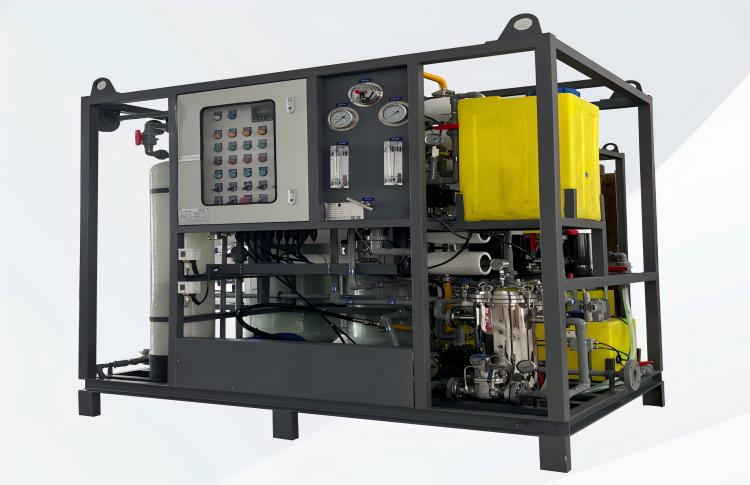Water is an essential resource for life, industry, and agriculture. However, with growing populations, climate change, and industrialization, freshwater resources are increasingly strained. According to the United Nations, over 2 billion people live in countries experiencing high water stress. As a result, the need for alternative water sources has never been more urgent. Seawater desalination has emerged as one of the most effective solutions to meet this demand. In this article, we will explore the importance of seawater desalination equipment, its benefits, and its applications in the modern world.
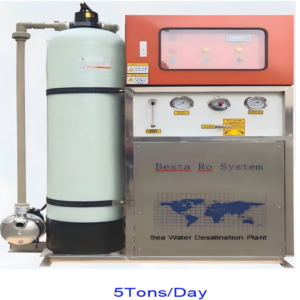
Seawater Desalination Plant(5Ton/Day)
What is Seawater Desalination?
Seawater desalination is the process of removing salt and other impurities from seawater to produce fresh, drinkable water. The primary technology used for desalination is reverse osmosis (RO), which uses semi-permeable membranes to filter out salts, bacteria, and other contaminants. In addition to reverse osmosis, thermal distillation and electrodialysis are also used, though they are less common for large-scale applications.
Global Water Crisis and the Role of Seawater Desalination
The global freshwater crisis is a pressing issue. According to a report by the World Bank, more than 40% of the global population lives in regions that are highly vulnerable to water scarcity. Furthermore, climate change is exacerbating the problem, leading to erratic weather patterns, droughts, and floods. Consequently, many countries are turning to seawater desalination as a reliable and sustainable solution for their water needs.
Table 1: Global Water Scarcity Statistics
| Region | Population Affected by Water Scarcity | Percentage of Global Population |
|---|---|---|
| Sub-Saharan Africa | 300 million | 10% |
| Middle East & North Africa | 300 million | 10% |
| South Asia | 600 million | 20% |
| Latin America | 100 million | 3% |
| Southeast Asia | 200 million | 7% |
As shown in Table 1, over 1.5 billion people across various regions of the world face significant water scarcity, highlighting the urgent need for alternative water sources such as desalinated water.
Benefits of Seawater Desalination Equipment
Seawater desalination equipment offers several key benefits, making it an essential technology in the fight against water scarcity:
1. Reliable Freshwater Supply
One of the primary advantages of seawater desalination is its ability to provide a consistent supply of freshwater. Unlike traditional water sources such as rivers and lakes, seawater is abundant and largely unaffected by seasonal changes or droughts. This makes desalinated water a reliable source for both urban and rural areas.
2. Energy Efficiency
Modern desalination systems are designed to be energy-efficient, reducing the overall cost of water production. For example, reverse osmosis systems typically require less energy compared to thermal distillation systems. The development of energy recovery devices has further optimized the energy consumption of desalination plants.
3. Environmental Impact
Although desalination uses energy, it has a relatively low environmental impact compared to other water extraction methods, such as damming rivers or groundwater pumping. Furthermore, desalination provides a solution for regions with saline groundwater or poor-quality surface water, preserving freshwater ecosystems.
4. Sustainable Solution for Water Scarcity
With increasing freshwater demand and dwindling natural resources, seawater desalination is seen as a sustainable solution. As of 2021, there are over 20,000 desalination plants worldwide, producing more than 100 million cubic meters of freshwater daily. This technology plays a crucial role in meeting the needs of both developing and developed nations.
Table 2: Global Desalination Plant Capacity
| Region | Number of Desalination Plants | Total Daily Capacity (Million Cubic Meters) |
|---|---|---|
| Middle East | 1,000 | 60 |
| Asia-Pacific | 5,000 | 25 |
| North America | 1,500 | 10 |
| Europe | 2,000 | 5 |
From Table 2, it is clear that desalination plays a vital role in regions such as the Middle East and Asia-Pacific, where freshwater sources are limited.
Applications of Seawater Desalination Equipment
Seawater desalination equipment is used in a variety of applications, including:
1. Municipal Water Supply
Desalination systems are widely used in coastal cities and islands where freshwater sources are either limited or non-existent. Countries like Saudi Arabia and the United Arab Emirates rely heavily on desalinated water to meet the needs of their growing populations.
2. Agricultural Use
In arid regions, desalinated water is used for irrigation. It can be mixed with freshwater to improve crop yields, particularly in regions where saline groundwater has been rendered unusable.
3. Industrial Use
Industries that require large amounts of water, such as oil and gas and food processing, often turn to desalination plants as a reliable water source. These industries benefit from the consistent and high-quality water provided by desalination.
4. Tourism and Remote Areas
Desalination is also essential for remote tourist destinations or island resorts. In places where freshwater transportation is costly or logistically challenging, desalinated water provides a cost-effective and reliable alternative.
Conclusion
In conclusion, seawater desalination equipment plays an increasingly important role in addressing the global water crisis. As freshwater resources become scarcer and climate change impacts water availability, desalination provides a viable and sustainable solution. With numerous benefits, including reliability, energy efficiency, and environmental sustainability, seawater desalination is poised to play a crucial role in the future of water supply. As technology continues to evolve, it is likely that desalination will become even more efficient and widespread, meeting the needs of populations around the world.

 MBR Membrane
MBR Membrane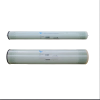 Reverse Osmosis Membrane
Reverse Osmosis Membrane Residential Ro Membrane
Residential Ro Membrane UF Membrane
UF Membrane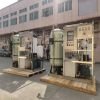 Water Treatment Plant
Water Treatment Plant Residential Ro Machine
Residential Ro Machine Brackish Ro System
Brackish Ro System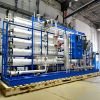 Sea water system/SW RO plant
Sea water system/SW RO plant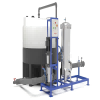 Membrane Cleaning System(CIP)
Membrane Cleaning System(CIP) Consumables Accessories
Consumables Accessories